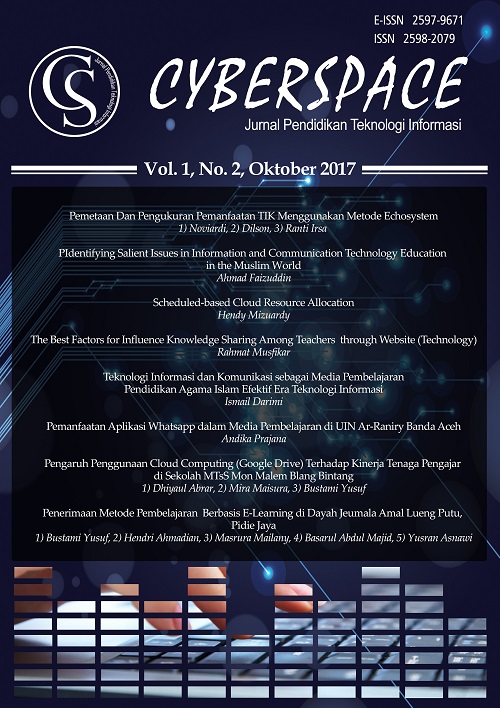IDENTIFYING SALIENT ISSUES IN INFORMATION AND COMMUNICATION TECHNOLOGY EDUCATION IN THE MUSLIM WORLD
DOI:
https://doi.org/10.22373/cs.v1i2.2012Kata Kunci:
Information and communication technology (ICT), ICT education, teachingAbstrak
Information and communication technology (ICT) in education has been widely used in many schools and learning institutions all over the world. However, the use of ICT in the Muslim world to improve the teaching and learning process is still limited. Indonesia as the most populace Muslim community in the world for instance, still does not have sufficient computer or Internet access in most of learning centers. This poses many challenges particularly in education. Young Muslims nowadays are caught between modernity and tradition. ICT can lead a Muslim to an ambiguous modern lifestyle and at the same time prying integrity of their identity. In some ways, Muslim youngsters are adopting technology with the aim to distance themselves from older people and traditional practices. On the other hand, there are some who challenge Western models. How should ICT education develop within an increasingly digital technological world? This article mainly highlights salient issues of ICT education in the Muslim world and the challenges of Muslim identity in the Internet era. It also examines the impact of digital technology on education for Muslim students and synthesizes ICT education from the Islamic point of view. Finally, some recommendations are appraised accordingly.Referensi
Chen, A. Y., Mashhadi, A., Ang, D., & Harkrider, N. (1999). Cultural issues in the design of technologyâ€enhanced learning systems. British Journal of Educational Technology, 30(3), 217-230.
Eickelman, D. F. (1999). The coming transformation of the Muslim world. Middle East Review of International Affair, 3(3), 78-81.
Ho, S. S., Lee, W., & Hameed, S. S. (2008). Muslim surfers on the internet: Using the theory of planned behaviour to examine the factors influencing engagement in online religious activities. New Media & Society, 10(1), 93-113. DOI: 10.1177/1461444807085323. Retrieved April 3, 2013 from http://nms.sagepub.com/content/10/1/93.
Huda, M. Q., & Hussin, H. (2010, December). ICT implementation barriers and organizational issues in Islamic-based Higher Education Institution: The case of Syarif Hidayatullah State Islamic University (UIN) Jakarta. In Information and Communication Technology for the Muslim World (ICT4M), 2010 International Conference on (pp. A18-A25). IEEE.
Khalid, F., Nawawi, M., & Roslan, S. (2009). Integration of ICT in Malaysian secondary schools: What conditions will facilitate its use?. The International Journal of Learning, 15(12), 85-94.
Kuriyan, R., Ray, I., & Toyama, K. (2008). Information and communication technologies for development: The bottom of the pyramid model in practice. The Information Society, 24(2), 93-104.
Lau, B. T., & Sim, C. H. (2008). Exploring the extent of ICT adoption among secondary school teachers in Malaysia. International Journal of Computing and ICT Research, 2(2), 19-36.
Lim, C. P., & Pannen, P. (2012). Building the capacity of Indonesian education universities for ICT in pre-service teacher education: A case study of a strategic planning exercise. Australasian Journal of Educational Technology, 28(6), 1061-1067.
Lubis, M. A., Embi, M. A., Yunus, M. M., Wekke, I. S., & Nordin, N. M. (2009). The application of multicultural education and applying ICT on pesantren in South Sulawesi, Indonesia. WSEAS Transactions on Information Science and Applications, 6(8), 1401-1411.
Mandaville, P. (1999). Digital Islam: Changing the boundaries of religious knowledge?. ISIM Newsletter, 2, 1.
Merrow, J. (November 3, 2009). Technology in schools: Problems and possibilities. Retrieved April 20, 2013 from http://takingnote.learningmatters.tv/?p=3261.
Proulx, C. (November 12, 2012). 5 ways technology will impact higher ed in 2013. Retrieved April 16, 2013 from http://www.forbes.com/sites/groupthink/2012/12/11/5-ways-technology-will-impact-higher-ed-in-2013/.
Sassen, S. (2002). Towards a sociology of information technology. Current Sociology, 50(3), 365-388. DOI: 10.1177/0011392102050003005. Retrieved April 3, 2013 from http://csi.sagepub.com/content/50/3/365.
Siddiqui, D. A. (1993). Selected Major Issues in Instructional/Communication Technology: An Islamic Perspective. MUSLIM EDUCATION QUARTERLY, 10, 57-57.
Wicklein, R. C. (2004). Critical issues and problems in technology education. The Technology Teacher, 64(4), 6-9.
Unduhan
Diterbitkan
Terbitan
Bagian
Lisensi
Authors who publish with Cyberspace Journal agree to the following terms:
- Authors retain copyright and grant the journal right of first publication with the work simultaneously licensed under a Creative Commons Attribution License that allows others to share the work with an acknowledgement of the work's authorship and initial publication in this journal.
- Authors are able to enter into separate, additional contractual arrangements for the non-exclusive distribution of the journal's published version of the work (e.g., post it to an institutional repository or publish it in a book), with an acknowledgement of its initial publication in this journal.
- Authors are permitted and encouraged to post their work online (e.g., in institutional repositories or on their website) prior to and during the submission process, as it can lead to productive exchanges, as well as earlier and greater citation of published work (See The Effect of Open Access).



















